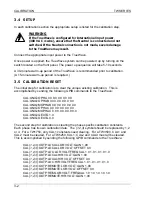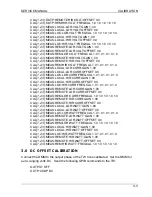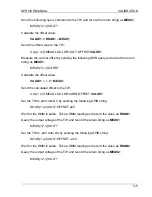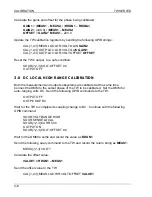
CALIBRATION
TW SERIES
3-16
Wait for the DMM reading to settle and record the value as
RDNG4
.
Query the TW’s output put voltage with the GPIB string below and record this value as
MEAS4
.
MEAS
{1,2,3}
:VOLT?
Set the TW’s frequency to 500 Hz with the following GPIB command:
SOUR:FREQ 500.0
Wait for the DMM reading to settle and record the value as
RDNG5
.
Query the TW’s output put voltage with the GPIB string below and record this value as
MEAS5
.
MEAS
{1,2,3}
:VOLT?
Set the TW’s frequency to 60 Hz and open the output with the following GPIB
commands:
SOUR:FREQ 60.0
OUTP OFF
Calculate the measurement system frequency compensation values:
VALUE1
=
RDGN1
/
MEAS1
VALUE2
=
RDGN2
/
MEAS2
VALUE3
=
RDGN3
/
MEAS3
VALUE4
=
RDGN4
/
MEAS4
VALUE5
=
RDGN5
/
MEAS5
Update the TW’s calibration data with the following GPIB command:
CAL
{1,2,3}
:MEAS:LOC:HIR:VOLT:FREQCAL
VALUE1 VALUE2 VALUE3 VALUE4 VALUE5
3.13 REMOTE LOW RANGE FREQUENCY CALIBRATION
Connect the TW output to the DMM. Set the DMM up for auto–ranging AC voltage.
Set the TW into AC coupling, remote sense, 40 Hz, 120V, and low range by sending
the following GPIB strings:
OUTP:COUP AC
SOUR:VOLT:RANGE LOW
SOUR:SENSE REMOTE
SOUR:FREQ 40.0
SOUR
{1,2,3}
:VOLT 120.00
Summary of Contents for TrueWave TW1750
Page 2: ......
Page 4: ...ii This page intentionally left blank ...
Page 10: ...TABLE OF CONTENTS TW SERIES viii This page intentionally left blank ...
Page 36: ...MAINTENANCE AND TROUBLESHOOTING TW SERIES 2 16 This page intentionally left blank ...
Page 80: ...CALIBRATION TW SERIES 3 44 This page intentionally left blank ...
















































